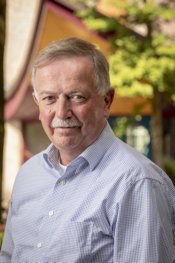Unwise government policy has given the Netherlands a serious traffic problem. For decades, spatial planning policy-makers have failed to take adequate account of the impact of individual travel behaviours, and of private car use in particular.
 This is the conclusion drawn by Professor Martin van Maarseveen, who this month takes his leave as Professor of Management of Urban-Regional Dynamics at the Faculty of Geo-Information Science and Earth Observation (ITC) at the University of Twente. Van Maarseveen notes that urban developers and traffic planners have seldom worked in close collaboration; it is only once an area’s urban functions have already been mapped out that traffic planners come into action. In his view, both disciplines should be involved in the planning of urban space. The Netherlands is currently providing an example of what the absence of an integrated spatial planning policy can lead to. “We have created growth centres all over the place with a predominantly residential function, where almost no work opportunities exist. Almere is a well-known example of this. Residents are forced to travel longer distances to reach their workplaces, facilitated by a high-density motorway network. In this way spatial planning has contributed towards the mass motorization of this country.”
This is the conclusion drawn by Professor Martin van Maarseveen, who this month takes his leave as Professor of Management of Urban-Regional Dynamics at the Faculty of Geo-Information Science and Earth Observation (ITC) at the University of Twente. Van Maarseveen notes that urban developers and traffic planners have seldom worked in close collaboration; it is only once an area’s urban functions have already been mapped out that traffic planners come into action. In his view, both disciplines should be involved in the planning of urban space. The Netherlands is currently providing an example of what the absence of an integrated spatial planning policy can lead to. “We have created growth centres all over the place with a predominantly residential function, where almost no work opportunities exist. Almere is a well-known example of this. Residents are forced to travel longer distances to reach their workplaces, facilitated by a high-density motorway network. In this way spatial planning has contributed towards the mass motorization of this country.”
Limits to car traffic
The Dutch road network has already been comprehensively expanded to meet the needs of growing numbers of car users. The same cannot be said, however, of the country’s rail network. Compared to the car, train journey times have hardly dropped at all over the last 40 years because no serious investments in the system have been made. Now that the economy is in top gear, the country’s roads are clogging up. “We’re all spending more and more time in traffic jams. We can’t just build more roads, because we’re reaching physical limits. Self-driving cars reduce this traffic problem but they won’t solve it. As long as transport stays this cheap the situation can only get worse.”
Van Maarseveen expects things to change of their own accord. Private car ownership levels will eventually fall, because in urban areas bicycles and public transport will offer faster and more affordable forms of transport. If a car is needed it will be rented or shared. “But this is a slow change.”
Compact building design
Developing countries in Africa, Asia and South America are in a position to learn from the Dutch experience. All over the world, cities are in danger of becoming overpopulated and unliveable. Planners will need to take account of a number of basic principles to slow down or effectively manage the growth of these cities.
“Compact building design is the main thing,” explains Professor Van Maarseveen. “You have to ensure that most of the facilities people need are located close to their homes: in the neighbourhood, ideally just a short walk or bike ride away. Then you need a high-quality public transport system between urban cores. Influencing people’s behaviour also plays an important role; in many countries the bicycle is still seen as the poor man’s transport. You can change that image, for instance by finding role models who ride cool bikes. Bikes have long been underestimated as a solution to traffic congestion in large cities. I’ve underestimated them too.”
A smart, integrated approach
China is currently trying to turn the tide. There, economic growth has given rise to numerous cities with over a million inhabitants, many of whom have abandoned their bicycles in favour of a car. The result: over-congested roads and worsening air quality. The Chinese government is now investing heavily in public transport systems combined with bike loans.
Other countries in Asia, Africa and South America could avoid this problem in advance. Van Maarseveen thinks that this opportunity represents an important task for his faculty. “Satellites, drones and mobile phones generate data that allow us to model urban and traffic development. If we do this well, we can slow down urban growth. We have a large network of alumni in those countries, who often hold critical posts and determine policy. In Kigali, for instance, the capital of Rwanda, a former ITC student is working on a new and sustainable urban design with room for pedestrians, cyclists, public transport, cars, and even a funicular railway, to make the city more liveable. Now that’s what I call a ‘high-tech human touch’.”






